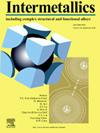氧化铝增强对AlCoCrFeNi高熵合金显微组织、硬度和摩擦学性能影响的研究
IF 4.8
2区 材料科学
Q2 CHEMISTRY, PHYSICAL
引用次数: 0
摘要
本研究考察了氧化铝(Al2O3)增强剂对高熵合金(HEA)显微组织、硬度和磨损性能的影响。采用机械合金化(MA)方法将0-15 wt%的Al2O3颗粒掺入HEA基体中,并用火花等离子烧结(SPS)方法对制备的粉末混合物进行固化剂处理。显微组织分析表明,基体合金呈现BCC相和FCC相的双相结构,在较高浓度(15 wt%)下,添加氧化铝使BCC相稳定。显微硬度测试表明,高达10 wt% Al2O3的掺入对硬度的影响最小,而15 wt% Al2O3的掺入将硬度从大约600 HV显著提高到999 HV。摩擦学研究表明,随着氧化铝含量的增加,复合材料的耐磨性提高,HEA-15 wt% Al2O3具有最低的磨损宽度(1892 μm)和最佳的磨损性能。主要的磨损机制包括磨损、脱层、粘附和氧化。这些发现突出了氧化铝增强HEAs在需要提高机械强度和耐磨性的应用中的潜力。本文章由计算机程序翻译,如有差异,请以英文原文为准。
Investigation of alumina reinforcement effects on microstructure, hardness, and tribological behavior of AlCoCrFeNi high entropy alloy
This study examines the effect of alumina (Al2O3) reinforcement on the microstructure, hardness, and wear behavior of AlCoCrFeNi high-entropy alloy (HEA). Al2O3 particles (0–15 wt%) were incorporated into the HEA matrix using mechanical alloying (MA) and the prepared powder mixtures were consolidated by spark plasma sintering (SPS) method. The microstructural examination showed that the base alloy displayed a dual-phase structure comprising BCC and FCC phases, with alumina addition stabilizing the BCC phase at higher concentrations (15 wt%). Microhardness tests indicated that the incorporation of up to 10 wt% Al2O3 had minimal impact on hardness, whereas 15 wt% Al2O3 significantly increased it from approximately 600 HV to 999 HV. Tribological investigations demonstrated that the wear resistance improved with increasing alumina content and HEA-15 wt% Al2O3 composite exhibited the lowest wear width (1892 μm) and the best wear performance. The primary wear mechanisms consisted of abrasion, delamination, adhesion, and oxidation. These findings highlight the potential of alumina-reinforced HEAs for applications requiring enhanced mechanical strength and wear resistance.
求助全文
通过发布文献求助,成功后即可免费获取论文全文。
去求助
来源期刊

Intermetallics
工程技术-材料科学:综合
CiteScore
7.80
自引率
9.10%
发文量
291
审稿时长
37 days
期刊介绍:
This journal is a platform for publishing innovative research and overviews for advancing our understanding of the structure, property, and functionality of complex metallic alloys, including intermetallics, metallic glasses, and high entropy alloys.
The journal reports the science and engineering of metallic materials in the following aspects:
Theories and experiments which address the relationship between property and structure in all length scales.
Physical modeling and numerical simulations which provide a comprehensive understanding of experimental observations.
Stimulated methodologies to characterize the structure and chemistry of materials that correlate the properties.
Technological applications resulting from the understanding of property-structure relationship in materials.
Novel and cutting-edge results warranting rapid communication.
The journal also publishes special issues on selected topics and overviews by invitation only.
 求助内容:
求助内容: 应助结果提醒方式:
应助结果提醒方式:


